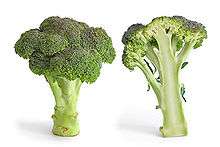Broccoli sprouts

Broccoli sprouts are three- to four-day-old broccoli plants that look like alfalfa sprouts, but taste like radishes.
History
While health-conscious people in the 1970s embraced raw sprouts as a dietary staple, it was not until the 1990s that broccoli sprouts became the mainstream. This is because in 1992[1] a team of Johns Hopkins University scientists isolated a cancer-fighting phytochemical in broccoli called glucoraphanin, which is the glucosinolate precursor of sulforaphane (SGS).[2] When chewed, broccoli releases glucoraphanin and myrosinase, an enzyme found in another part of the plant cell, which work together to produce sulforaphane, which, in turn, activates a transcription factor, Nrf2 in the cell. Once activated, Nrf2 then translocates to the nucleus of the cell, where it aligns itself with the antioxidant response element (ARE) in the promoter region of target genes. The target genes are associated with process which assists in regulating cellular defences. Such cytoprotective genes include that for glutathione. Around 200 genes have been well-characterised, as many as 1700 are thought to be related to this aspect of cellular defense.
The 1992 study was followed by the discovery in 1997[3] that glucoraphanin is in higher concentrations in the three- to four-day-old broccoli sprouts, at least 20 times the concentration of full grown broccoli. This discovery was written about in the New York Times,[4] and created a global shortage of broccoli seed that could not meet the sudden high demand.
Nutrition
Broccoli sprouts actually have lower nutritional values than full sized broccoli according to the USDA.[5] Many studies compare the nutritional value of dry, dormant seeds to sprouts to obtain an exaggerated positive result for sprouts. However, the sprouts are not typically consumed for their nutrient content; they are consumed for their content of bioactive molecules with potent nutrigenomic potential. Broccoli sprouts contain a particular glucosinolate compound, glucoraphanin, which is found in vacuoles within the cytoplasm of the plant cell. The membrane of the plant cells also contain an enzyme, myrosinase, which is walled off from the vacuoles of glucoraphanin. Only when the plant cell is ruptured by cutting, chewing, etc. do the two substances come into contact with each other. In the moist environment of the cell, this leads to a chemical reaction wherein the myrosinase converts the glucoraphanin to an isothiocyanate, sulforaphane. It is predominantly the sulforaphane for which broccoli sprouts have been so widely researched. The glucoraphanin of itself is inert.
Medical research
Broccoli sprouts are rich in sulforaphane, a compound that is under investigation for its anti-cancer properties.[6] Eating broccoli sprouts is not however considered to be a means of targeting cancer with sulforaphane.[6]
Availability
Broccoli sprouts are available in grocery and natural foods stores across the United States and in other countries. Broccoli seeds are available for home growing. One can sprout broccoli seeds using a jar or a commercial sprouting kit. Broccoli sprout powders and capsules are also available. However, many of these products are produced from myrosinase-inactive sprout or seed extracts. It is difficult, if not impossible, for the consumer to identify which products contain both the essential precursor glucoraphanin as well as the active myrosinase enzyme. With a myrosinase-inactive product, an individual may not convert any of the glucoraphanin to sulforaphane. Because so little is known about the role of human gut microflora at this stage, reliance on the gut microflora with its wide variability could pose a significant limitation on the achievement of a biochemical response.
Sprout safety
The U.S. Food and Drug Administration (FDA) issued suggested protocols[7] recommending commercially grown sprout seeds be soaked and sterilized with 20,000 PPM calcium hypochlorite prior to sprouting.
A study published in Nutrition Journal quantifies the effectiveness of sprout safety programs.[8]
References
- ↑ Y Zhang, et al. (1992) A major inducer of anticarcinogenic protective enzymes from broccoli: isolation and elucidation of structure, Proc. Natl Acad. Sci., 89:2399–2403 .
- ↑ Angier, Natalie (1992-03-15). "Potent Chemical To Fight Cancer Seen in Broccoli – The". New York Times. Retrieved 2009-11-16.
- ↑ P. Talalay, et al. (1997) Broccoli sprouts: An exceptionally rich source of inducers of enzymes that protect against chemical carcinogens, Proc. Natl. Acad. Sci., 94:1036710372.
- ↑ Angier, Natalie (1997-09-16). "Researchers Find a Concentrated Anticancer Substance in Broccoli Sprouts – The". New York Times. Retrieved 2009-11-16.
- ↑ Nutrient Data Laboratory Archived July 11, 2010, at the Wayback Machine.
- 1 2 "Broccoli and breast cancer". NHS Choices. 5 May 2010. Retrieved 8 November 2015.
- ↑ "Guidance for Industry: Reducing Microbial Food Safety Hazards For Sprouted Seeds". fda.gov.
- ↑ Fahey JW, Ourisson PJ, Degnan FH (2006). "Pathogen detection, testing, and control in fresh broccoli sprouts". Nutr J. 5: 13. doi:10.1186/1475-2891-5-13. PMC 1523358
 . PMID 16630354.
. PMID 16630354.

